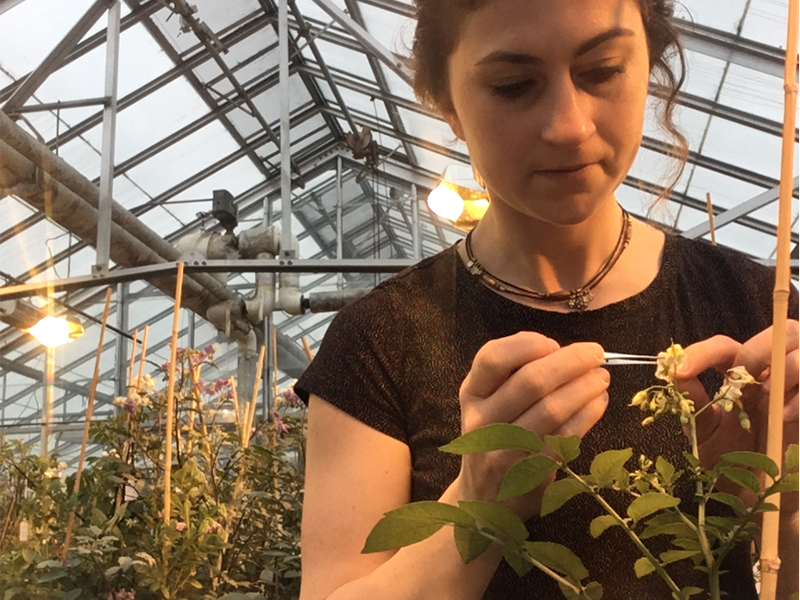
I can not help but follow this research. It is a natutral continuation of my highschool agricultural classes that could be better described as empirical biology. what every farm boy needs to know and yes, understand.
I have watched as our understanding of genetic manipulation has nicely deepened, but also with alarm as elements outside of agriculture try to do things that the agricultural crowd would shy from. this shit can bite. In fact it has done just that by coming in from the wild over and over again.
We need to make it much more dificult for monocultures to be attracked and so far our greenhouses do it best.
It may well that our true future will be south facing green houses attached to our condo towers. A wall of greenery loaded with bare root and fruit production, cycling every two to three months.
Breeding beetle-resistant potatoes
Natural resistance to potato pest can increase yield of America’s favorite vegetable
September 22, 2021 - Potatoes are the most consumed vegetable in the United States. According to the USDA, US farmers grew more than 42 billion lbs. of potatoes in 2019. That’s 128 lbs. of potatoes per person.
But farmers growing potatoes face many challenges. One tiny, yet devastating, pest is the Colorado potato beetle. It can cause immense damage to potato crops. It’s also notorious for becoming resistant to chemical insecticides.
In a new study, published in Crop Science, researchers describe genetic tools to develop potato varieties with improved natural resistance to the potato bug. Crop Science is a publication of the Crop Science Society of America.
They also developed key genetic resources – called recombinant inbred lines – that will aid in breeding new potato varieties.
The Colorado potato beetle can devastate potato production. But some wild relatives of the domesticated potatoes have natural defenses against these beetles. These wild plants make their own beetle-killing compounds.
“Some of these compounds can kill Colorado potato beetle larvae,” said Natalie Kaiser, lead author of the study. “These compounds also dramatically reduce adult beetle feeding.”
But consuming large amounts of these compounds can have adverse health effects in humans.
While beetles chomp on potato leaves, humans obviously do not. “So, it is desirable to create potato varieties that make these anti-beetle compounds only in their leaves,” says Kaiser, a researcher at Michigan State University.
But generating this beetle-resistant variety of potato has been a challenge of many layers.
One challenge is testing potato varieties for beetle resistance. Field trials can take months if not years. They can also be costly and resource intensive.
Kaiser and colleagues developed a research shortcut.
They compared the chemical profile of hundreds of individual potatoes with their resistance to the Colorado potato beetle in the field.
“We found chemical signatures that could predict resistance to Colorado potato beetles,” says Kaiser. “Breeders can select resistant potatoes with a simple chemical measurement instead of having to conduct field trials.”
This method could save time and money.
Another obstacle in breeding beetle resistant potatoes is the sheer amount of genetic information breeders need.
“There are several genes controlling the types and amounts of anti-beetle compounds that any given potato variety will produce,” says Kaiser. It is challenging to track all those genes during breeding.
Potato breeders also have to keep in mind other traits, like yields and tuber appearance.
“There are approximately 40 important traits to consider when developing a new potato variety,” says Kaiser. “Assembling the right combination of genes controlling all these traits is crucial.”
This process is complicated by the fact that potato varieties often have four copies of every gene. Potato isn’t the only crop to have multiple gene copies, which is called polyploidy.
Having four copies of each gene can make potato genetics complicated, according to Kaiser. “Each of the four copies can be a different version of the gene,” she says.
One way around the four-copies problem is to use potato varieties that naturally only have two copies of each gene. Humans, like most animals have two copies of every gene – one each from male and female parents. This is called diploid.
But many of diploid potato varieties are self-incompatible. “This means that a plant will not set fruit and seed when a flower is pollinated with its own pollen,” says Kaiser. This reproductive barrier makes breeding very challenging.
Kaiser and her team developed diploid potatoes that are self-compatible. Through this process Kaiser and her team discovered that multiple genes and the environment determine whether some potatoes can produce self-fruit and seed.
The new potato varieties and genetic tools will allow researchers to “examine the genetic foundations of self-fertility, and insect and disease resistance,” says Kaiser. “This way, we can create new potato varieties that were previously infeasible,” says Kaiser.
Researchers at Michigan State University are extending this research in field trials this summer. “We will screen new potato varieties for individuals that have good tuber characteristics along with beetle resistance,” says Kaiser.
Photo Caption: Study author Natalie Kaiser crossbreeding potatoes that have strong Colorado potato beetle resistance to potatoes with good tuber production in the greenhouse. She is using small forceps to select the male part of the flower, the anthers. Credit: Natalie Kaiser
High-resolution images for use with this story only available by emailing Susan Fisk, sfisk@sciencesocieties.org.
No comments:
Post a Comment